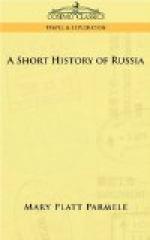The Raskolniks, composed chiefly of free peasants and the smaller merchant class, had fled in large numbers from these blasphemous changes—some among the Cossacks, and many more to the forests, hiding from persecution and from this reign of Satan. The more they studied the Apocalypse the plainer became the signs of the times. Satan was being let loose for a period. They had been looking for the coming of Antichrist and now he had come! The man in whom the spirit of Satan was incarnate was Peter the Great. How else could they explain such impious demeanor in a Tsar of Russia—except that he was of Satanic origin, and was the Devil in disguise? By his newly invented census had he not “numbered the people”—a thing expressly forbidden? And his new “calendar,” transferring September to January, was it not clearly a trick of Satan to steal the days of the Lord? And his new title Imperator (Emperor), had it not a diabolic sound? And his order to shave, to disfigure the image of God! How would Christ recognize his own at the Last Day?
Hunted like beasts, these people were living in wild communities, dying often by their own hands rather than yield the point of making the sign of the cross with two fingers instead of three—2700 at one time voluntarily perishing in the flames, in a church where they had taken refuge. Peter put an end to their persecution. They were permitted to practice their ancient rites in the cities and to wear beards without molestation, upon condition of paying a double poll-tax.
The millions of Raskolniks in Russia to-day still consider New Russia a creation of the evil one, and the Tsar as Antichrist. They yield a sullen compliance—pray for the Tsar, then in private throw away the handle of door if a heretic has touched it. It is a conservative Slavonic element which every Tsar since Mikhail Romanoff has had to deal with.
Not one of the reforms was more odious to the people than the removal of the capital from Moscow to St. Petersburg. It violated the most sacred feelings of the nation; and many a soul was secretly looking forward to the time when there would be no Peter, and they would return to the shrine of revered associations. But the new city grew in splendor—a city not of wood, to be the prey of conflagrations like Moscow; but of stone, the first Russia had yet possessed. The great Nevski was already there lying in a cathedral bearing his name, and the Cathedral of Sts. Peter and Paul was ready to entomb the future Tsars. And Peter held his court, a poor imitation of Versailles, and gave great entertainments at which the shy and embarrassed ladies in their new costumes kept apart by themselves, and the attempt to introduce the European dances was a very sorry failure. In 1712 Peter planned a visit to Paris, with two ends in view—a political alliance and a matrimonial one. He ardently desired to arrange for the future marriage




